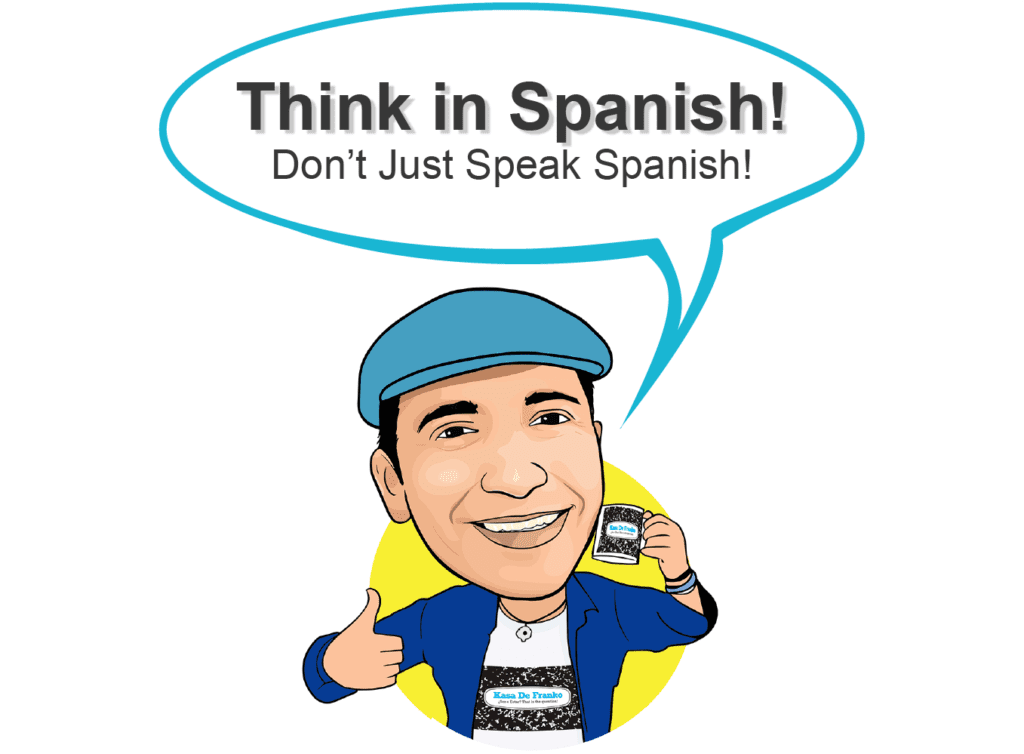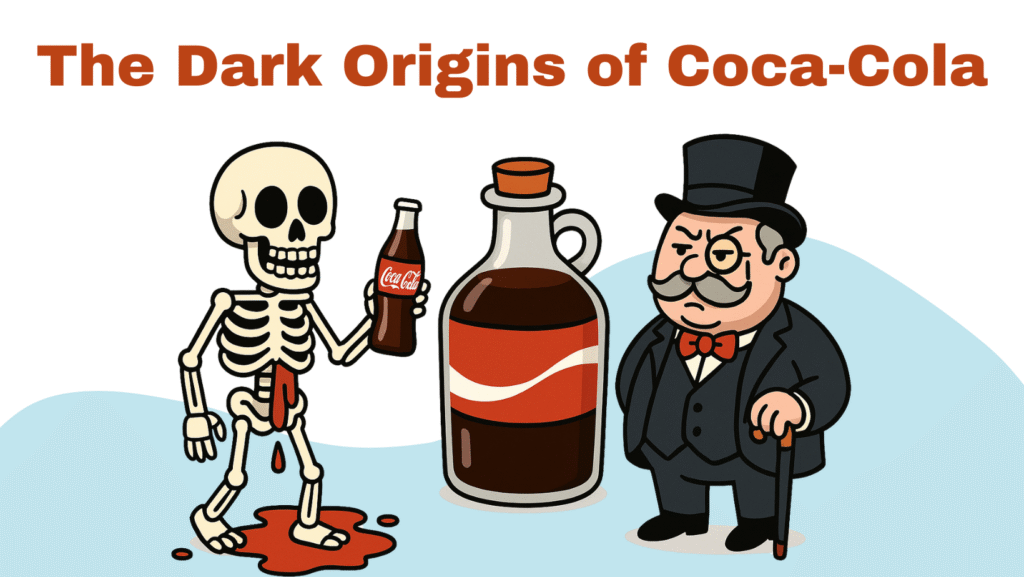
The World’s Favorite Black Poison
Ah, Coca-Cola. That sweet, fizzy icon of Americana, globalism, and sugar addiction. It’s the drink of choice for moviegoers, fast food lovers, and entire nations alike. But behind that familiar red label lies a story far less bubbly — a tale of corruption, labor abuse, health disasters, and cultural conquest. Welcome to Coca-Cola’s dirty secrets of blood and power — a dark cocktail of capitalism, imperialism, and syrup.
And no, we’re not just talking about tooth decay or a caffeine buzz — we’re diving into a history drenched in racism, exploitation, corporate corruption, and even murder.
If you’ve ever sipped a Coke and thought, “This tastes like capitalism,” you weren’t wrong.
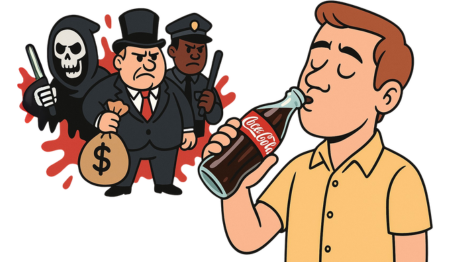
Coca-Cola’s Dirty Secrets of Blood & Power
What happens when a fizzy drink becomes a global empire? You get more than cavities — you get coups, killings, and corporate colonization in a can.
Coca-Cola isn’t just a beverage; it’s a blueprint. A masterclass in building a brand so powerful it can sweet-talk presidents, silence critics, and steamroll entire communities — all while selling you a smile. It’s not just sugar water. It’s imperialism in a bottle, disguised with bubbles and a cherry-red label.
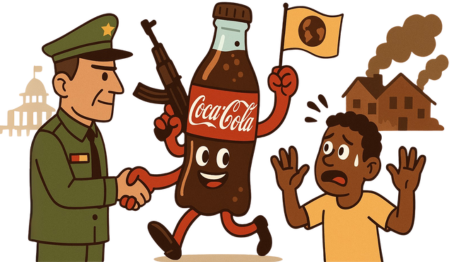
A Trail Anything but Refreshing
Let’s talk receipts.
In Colombia, union leaders organizing Coca-Cola workers were kidnapped, tortured, and murdered — while the company played dumb and denied responsibility. In India, entire villages went dry as Coke’s bottling plants drained aquifers faster than the monsoons could refill them. In Guatemala, workers disappeared. In Mexico, communities were left to drink Coca-Cola because clean water was harder to find than a cold can.
And in the U.S.? It’s business as usual: cashing in on nostalgia while lobbying hard to keep sugar taxes low and corporate accountability even lower.
Meanwhile, Coca-Cola ads keep whispering “happiness” and “unity” — but you might want to read the fine print. Because this isn’t just drinking the Kool-Aid. It’s swallowing a whole system of corruption, exploitation, and power — carbonated and trademarked.
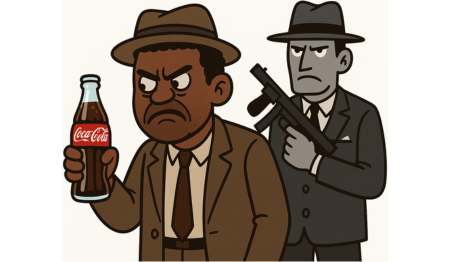
Born From a Bottle of Pain
Before Coca-Cola was a global symbol of fun and refreshment, it was a bitter cocktail of addiction, desperation, and snake-oil salesmanship. The story begins with John Pemberton, a Confederate veteran who, like many others, came home from the Civil War with more than trauma — he brought back a raging morphine addiction, courtesy of battlefield medicine.
To kick the habit (or at least shift it), Pemberton concocted a drink based on two of the hottest drugs of the day: coca leaves (yep, the stuff that makes cocaine) and kola nuts (caffeine-packed little devils). The original formula? A delightful mix of cocaine, caffeine, sugar, wine — and a whisper of marketing genius. He called it French Wine Coca.
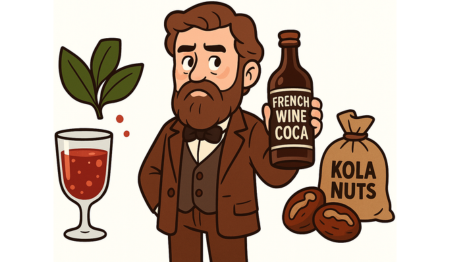
But Boom: Alcohol Was Banned!
When Atlanta banned alcohol in 1886, Pemberton had to pivot. He scrapped the wine, kept the coca, added some fizz — and rebranded. Thus was born Coca-Cola, the non-alcoholic miracle tonic that would soon conquer America.
Spoiler: he never kicked the addiction. He died broke and sick in 1888, selling off the rights to the formula he once believed would save his soul — a bitter origin for what would become a billion-dollar empire built on Coca-Cola’s dirty secrets of blood and power.
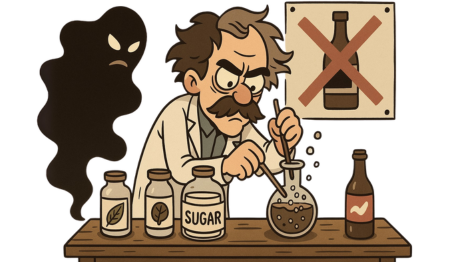
Racism in a Bottle
By the early 20th century, Coca-Cola wasn’t just a drink — it was a moral panic. Newspapers fanned the flames of racial fear, claiming that Black men hopped up on Coca-Cola (read: cocaine) were a threat to white women and Southern order. The myth of the “cocaine-crazed negro” was born — a dangerous lie that helped fuel racist policies and hysteria.
But beyond the headlines and hysteria, it served another purpose: hiding Coca-Cola’s dirty secrets of blood and power behind a smokescreen of moral panic and racial fear.
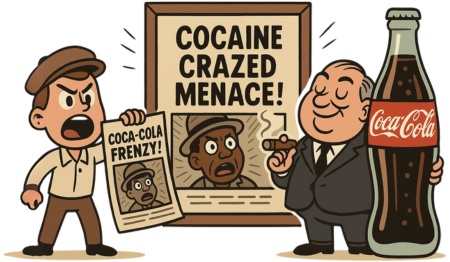
Removing the Cocaine from the Coke
Under this racist pressure, the Coca-Cola Company quietly began removing the cocaine from the drink by 1903 (although it kept using decocainized coca leaf extract — a fact still true today, thanks to a special federal license given only to Coca-Cola’s supplier, the Stepan Company).
So yes, the U.S. government banned coca leaf imports — except for Coke. And racist drug policies that began with Coca-Cola’s demonization still echo today in mass incarceration and drug law disparities.
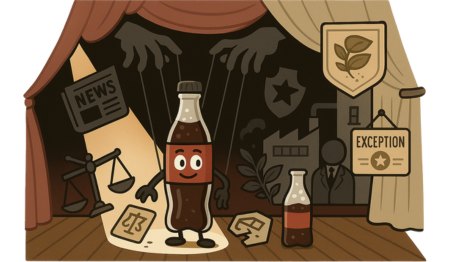
The Real Dirty Secret Ingredient: Blood?
Coca-Cola’s rise wasn’t just about flavor — it was about bulldozing the competition. Under Asa Candler, Coke turned into a marketing monster. And under Robert Woodruff, it became a global empire.
They sold Coca-Cola as a lifestyle, a patriotic symbol, even a religious experience. During WWII, Woodruff declared that every U.S. soldier should get a Coke for 5 cents — wherever they were in the world. Coke followed troops into Europe, Africa, and the Pacific, setting up bottling plants in war zones.
By war’s end, the infrastructure was already in place: Coke didn’t just enter global markets — it had already conquered them.
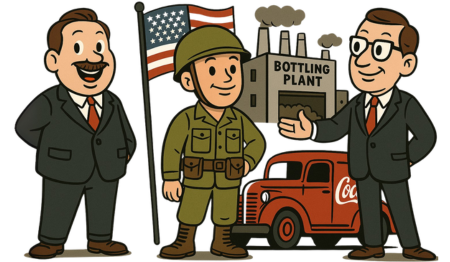
The Killings Behind the Bubbles
Now let’s talk blood.
In Colombia and Guatemala, Coca-Cola bottling partners have been accused of funding, aiding, or failing to prevent the murder of union leaders.
In the early 2000s, the Colombian food and beverage union SINALTRAINAL sued Coca-Cola, claiming that its bottlers had hired paramilitary death squads to threaten, kidnap, and kill labor organizers.
Workers who dared to demand better pay or working conditions often found themselves on hit lists. Some were murdered inside bottling plants. Others were forced to flee their homes or go into hiding.
Coca-Cola denied direct involvement, but human rights groups and journalists have documented a disturbing pattern of abuse, silence, and complicity.
The case was dismissed in U.S. courts on jurisdictional grounds — but the stories, and the blood, remain.
We’ll discuss it in more detail later on the article.
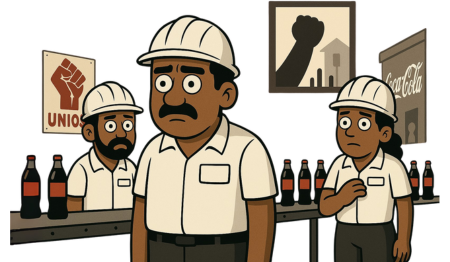
Liquid Sugar, Solid Lies
Coca-Cola isn’t just dangerous because of politics — it’s a public health disaster.
Each can of Coke contains about 10 teaspoons of sugar. That’s over 100% of the daily recommended amount for an adult — and it hits your bloodstream faster than a cupcake.
The result? A global explosion of type 2 diabetes, obesity, heart disease, and metabolic disorders. Coke didn’t invent sugar addiction, but it mastered the art of turning it into profit.
And when governments tried to push back — with soda taxes or school bans — Coca-Cola fought tooth and nail, funding front groups, fake research, and lobbying campaigns to silence scientists and block regulations.

Coke vs. the World: Imperialism in a Red Label
Coca-Cola’s expansion often mirrors America’s foreign policy. The drink followed the flag — showing up wherever U.S. interests landed.
- In Vietnam, U.S. troops drank Coke while bombing the countryside.
- In Iraq, local bottlers kept Coke flowing despite sanctions and war.
- In Africa, Coke became a dominant economic player, often using its power to crush competitors and shape local economies.
To be clear, Coke didn’t just sell soda — it sold American identity, capitalism, and consumerism.And it did so with special protections from governments, exclusive licenses, and monopolistic muscle.
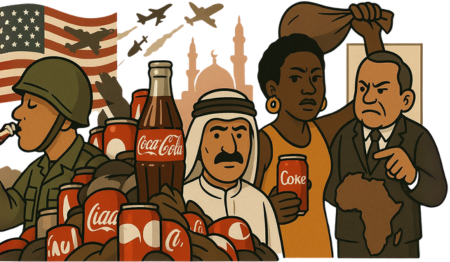
Plastic, Pollution, and PR Spin
Coca-Cola is the largest plastic polluter in the world, according to global audits by Break Free From Plastic.
Every year, it produces over 3 million tons of plastic packaging — much of it ending up in landfills, rivers, and oceans.
The company pledged to go green, of course. Lots of promises, very little action. Because reusable bottles and sustainable practices cut into one thing Coke truly worships: profit margins.
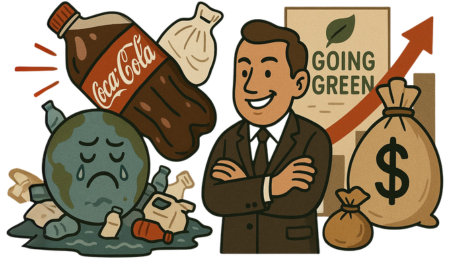
Coke in Schools, Hospitals, and Prisons
Where there are vulnerable people, there is Coca-Cola. The company has struck exclusive deals to sell its drinks in public schools, hospitals, universities, and even prisons.
This ensures early brand loyalty, especially among children, who grow up associating sugar and caffeine with comfort, celebration, and reward.
It’s not just unethical — it’s a predatory business model dressed in happiness and holiday commercials.
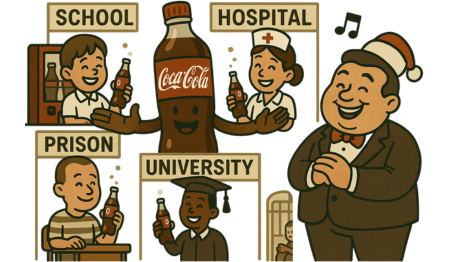
Final Sip: What Are You Really Drinking?
Coca-Cola wants to be your friend. Your nostalgia. Your childhood. Your comfort food.
But behind the polar bears and Santa Claus ads lies a brutal truth:
- A company built on racism, addiction, and labor exploitation
- A brand that thrives on disease, pollution, and political manipulation
- A drink that once contained cocaine, and now delivers a sugar bomb to your liver
It’s not just a beverage. It’s a machine — fueled by capitalism, secrecy, and global domination.
So the next time someone offers you a Coke, remember: you’re not just opening a bottle. You’re opening a century of blood, lies, and bubbles.
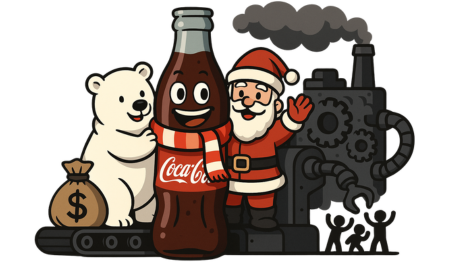
🩸 Blood, Bottles & Bulldozers: Coca-Cola’s War on Workers
You know that refreshing fizz? In some parts of the world, it’s carbonated with blood.
Behind Coca-Cola’s squeaky-clean, all-American branding lies a chilling history of intimidation, exploitation, and outright violence — especially against union workers fighting for dignity in Coca-Cola’s bottling plants across the Global South.
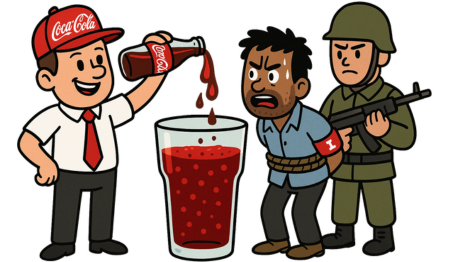
Colombia: Where Organizing Gets You Killed
Let’s start with Colombia, where the words “labor union” might as well come with a death sentence. Since the late 1980s, dozens of union leaders working at Coca-Cola bottling plants were kidnapped, tortured, or assassinated — not by vague “unidentified actors,” but allegedly with the direct involvement of plant managers and local paramilitary groups.
In 1996, the president of SINALTRAINAL (the food workers’ union), Isidro Gil, was gunned down inside a Coke-affiliated bottling plant. A day later, armed men torched the union’s office. Workers were reportedly given a choice: sign a resignation letter or get shot.
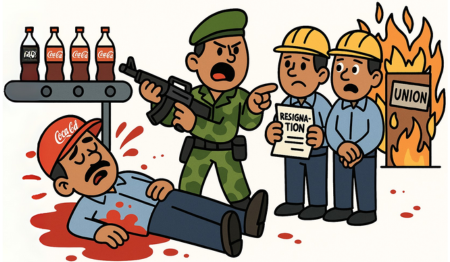
A Systematic Campaign of Terror
This wasn’t an isolated incident — it was a systematic campaign of terror. And while Coca-Cola denies direct involvement, the lawsuits, eyewitness testimonies, and relentless pattern of violence tell a darker story.
Oh, and did we mention that U.S. universities and student groups launched massive boycotts of Coca-Cola over this? Yeah. You probably didn’t see that in their Christmas ads with the polar bears.
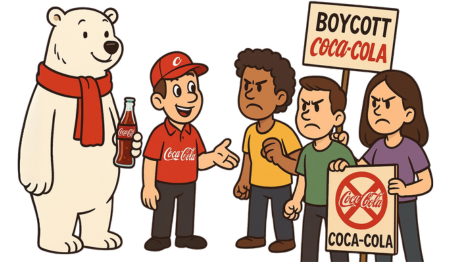
Guatemala: Corporate Muscle with Real Guns
In Guatemala, it’s the same script, different setting.
Coca-Cola bottlers became notorious for their violent suppression of labor rights. During the Guatemalan civil war, nine union leaders were murdered, and others were “disappeared” after demanding basic rights like health benefits and bathroom breaks.
And what did Coca-Cola HQ say? Essentially: “Not our problem. Those are just our franchisees.”
That’s like a mafia boss shrugging off a hit because he didn’t pull the trigger personally. The reality is this: Coca-Cola benefits from weak oversight and local corruption, outsourcing both their production and their brutality.
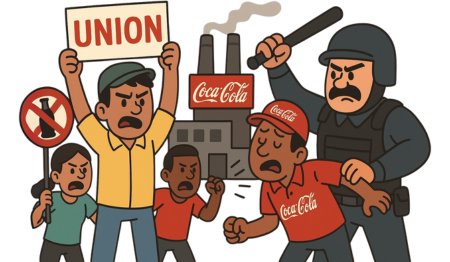
🧪 Public Health vs. The Soda Empire
Coca-Cola is basically liquid nostalgia with a PhD in seduction — and a side hustle in diabetes. One 12-ounce can? About 10 teaspoons of sugar. That’s not a treat. That’s an ambush.
The World Health Organization recommends less than 6 teaspoons of added sugar per day. With a single can of Coke, you’re already deep in the red. And guess what? Kids aren’t sipping one can. They’re guzzling liters.
But Coca-Cola knew this. And instead of pulling back, they leaned in — hard. They funded bogus studies to shift blame from sugar to fat, pushed “exercise more” campaigns, and hired PR teams to rebrand soda as a lifestyle choice instead of a health hazard.
Result? Obesity rates exploded across the globe. Type 2 diabetes became a childhood diagnosis. And Coke smiled all the way to the bank.
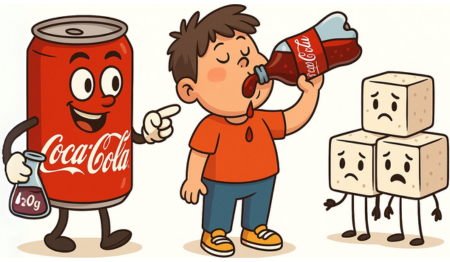
🍩 The Obesity Engine: How Coke Hijacked Health
Now let’s talk about the other slow death: metabolic collapse, diabetes, and obesity — one sip at a time.
A single 20 oz bottle of Coca-Cola contains about 65 grams of sugar — that’s 16 teaspoons. Try putting that much sugar in your tea and not vomiting.
But Coke doesn’t just sweeten your drink — it sweet-talks scientists too.
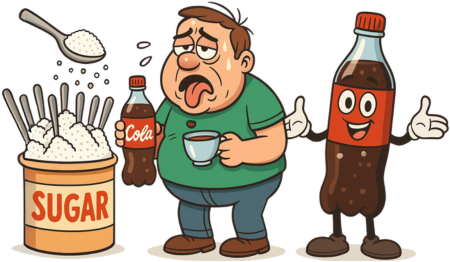
Science For Sale
In the 2010s, investigations revealed Coca-Cola had been funding “scientific” studies to downplay the link between sugary drinks and obesity. Enter the Global Energy Balance Network, a group of researchers who argued that exercise, not diet, was the real key to fighting obesity.
Guess who funded them? Yep — Coca-Cola. To the tune of millions of dollars. It’s a classic strategy: blame the victim, shift the narrative, and keep selling soda. When public health officials pointed the finger at sugar, Coke handed them a treadmill.
If you wanna learn more about Coca-Cola’s Dirty Secrets of Blood and Power sign up for our Spanish Socials!
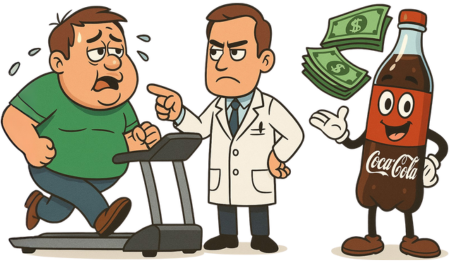
Targeting the Vulnerable
In low-income neighborhoods across the U.S., Latin America, and Africa, Coca-Cola’s strategy is crystal clear: make soda cheaper than water, and twice as addictive. In Mexico, per capita soda consumption is among the highest in the world — and so is the rate of childhood diabetes.
Fun fact (that isn’t fun): In some rural parts of Chiapas, Coca-Cola is used in religious rituals. Why? Because tap water is unsafe, and Coke is everywhere. That’s not just brand loyalty — that’s brand colonialism.
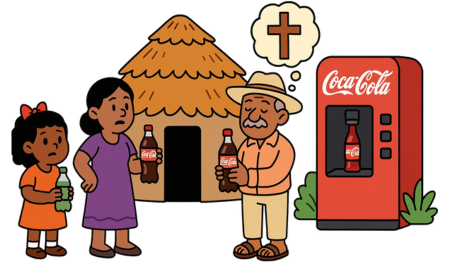
🌎 The Planet Fizzles: Plastic, Water Theft & Pollution
Coca-Cola isn’t just bad for your body — it’s brutal for the planet.
Let’s start with plastic. Coca-Cola is the #1 plastic polluter in the world. Not once. Not twice. Every single year according to multiple global audits. You know those bottles you “recycle”? Yeah, Coke lobbied to make sure that’s your problem, not theirs.
Then there’s the water crisis. From India to Mexico, Coca-Cola has been accused of draining local water sources, leaving entire communities dry while its factories keep churning out bubbly sugar water. In Kerala, India, farmers literally staged protests as their wells dried up — and Coca-Cola brushed them off like flat soda.
Even the air isn’t safe. The carbon footprint of global Coke transportation, refrigeration, and mass production is a climate punch in the gut.
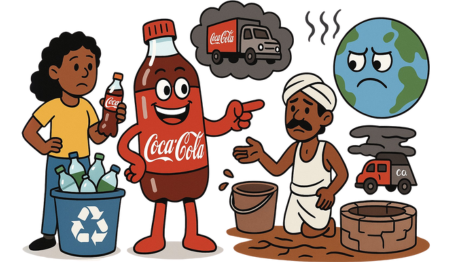
🧠 Mind Control in the Lunchroom: Coke in Schools, Prisons & Pop Culture
Coca-Cola is not just a brand. It’s a mindset, and it’s been targeting you since you were in diapers.
In the ’90s and 2000s, Coke launched aggressive campaigns to get into schools, offering “free vending machines” and sponsoring “athletic events.” But they weren’t giving — they were infiltrating. They knew exactly what they were doing: brand loyalty starts young.
They also signed exclusive contracts with universities and even prisons, ensuring that when you needed a drink — there was no Pepsi. There was no water. There was only Coke.
Add in decades of Hollywood product placements, from “American Idol” to every other blockbuster movie, and suddenly Coca-Cola isn’t just a drink. It’s part of your identity. Your culture. Your habits. Your cravings.
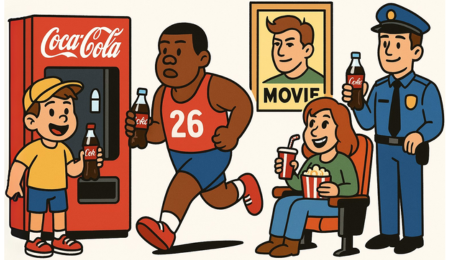
Coca-Cola Horoscope (Just for Fun, Or Is It?)
- Aries: You’re a Cherry Coke person. Aggressive sugar. Bold fizz. Chaos in a can.
- Taurus: Vanilla Coke. You say you like it “for the flavor” but really, you just don’t like change.
- Gemini: Diet Coke. Because one version of you wants health. The other still wants bubbles.
- Cancer: Mexican Coke. You swear it’s better. We know.
- Leo: Coke with your name on the label. Because attention must be paid.
- Virgo: Mini cans. 90 calories. Perfect portion. Still anxious.
- Libra: Share a Coke? You’d rather negotiate peace treaties with Pepsi.
- Scorpio: You still remember New Coke and you haven’t forgiven anyone.
- Sagittarius: You tried Coke Starlight and pretended you liked it.
- Capricorn: You secretly drink Coke Zero but only with spreadsheets.
- Aquarius: You believe Coca-Cola is a metaphor for capitalism. You’re not wrong.
- Pisces: You once cried during a Coke commercial. It happens.
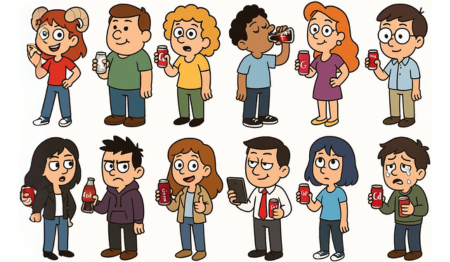
🔥 Final Sips: So What Now?
You can’t boycott your way out of this. Coke is everywhere. In stores, schools, planes, dreams. But you can wake up.
Every time you crack open a can, remember: you’re not just drinking caramel-colored bubbles — you’re swallowing a century of marketing, manipulation, and monopoly.
And that… that’s the real taste of Coca-Cola.
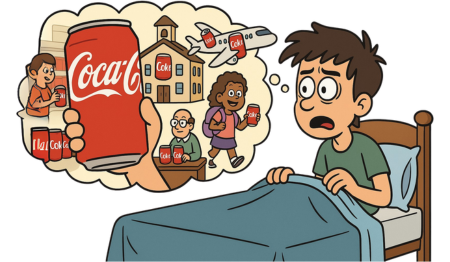
🧠 So… Why Does This Matter If You’re Learning Spanish?
Because while Coca-Cola was sabotaging unions in Colombia and turning Mayan ceremonies into marketing moments, most people were out here thinking tomar just meant “to drink.” In Latin America, though, tomar Coca-Cola sometimes means swallowing a whole system — of exploitation, culture-washing, and corporate power.
It’s not just language you’re sipping — it’s Coca-Cola’s dirty secrets of blood and power.

Don’t Just Learn Spanish
And that’s exactly why at Kasa de Franko, we don’t just teach Spanish — we teach how language connects to power, history, and resistance. Whether you’re learning with our main Spanish program or letting your little ones dive into culture through KiDeeF Spanish, it’s all about seeing the full picture — no corporate filters, no cultural shortcuts.
🧃So if you’re ready to speak Spanish and decode the world behind it…
🇵🇪 Grab a free lesson at Kasa de Franko.
Spanish for rebels, thinkers, and anyone tired of drinking the same old syrupy story.
